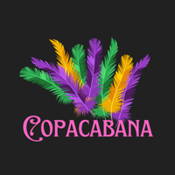
Overview
Synopsis
Copacabana (The Musical) follows Stephen, an aspiring songwriter in modern-day New York City, who dreams of creating a hit musical. As he begins to compose, his imagination transports him—and the audience—into the glitzy world of the late 1940s Copacabana nightclub. There, Stephen’s alter ego, Tony Starr, is a charming songwriter and emcee who falls in love with Lola La Mar, a hopeful young showgirl newly arrived from small-town America. With Tony’s encouragement, Lola becomes the club’s newest star, dazzling audiences with her energy and warmth.
Their success is threatened when Rico, the suave but dangerous owner of the Tropicana nightclub in Havana, becomes obsessed with Lola and abducts her. Tony follows her to Cuba, where he must rescue her from Rico’s control and restore her freedom. Through courage, love, and song, Tony and Lola are reunited, and Stephen’s musical vision reaches its triumphant finale. The story concludes with Stephen realizing that his imaginary romance has inspired him to pursue his dreams—and that the spirit of the Copacabana, “the hottest spot north of Havana,” will live on forever.
Show Information
Context
Copacabana (The Musical) originated from Barry Manilow’s 1978 chart-topping song “Copacabana (At the Copa),” which told the story of showgirl Lola and her lover Tony in a glamorous 1940s nightclub. The song’s popularity inspired Manilow, along with his longtime collaborators Bruce Sussman and Jack Feldman, to expand the story into a full-length television musical in 1985. That TV film, starring Manilow as Tony Starr and Annette O’Toole as Lola, was a hit with audiences and laid the groundwork
to read the context for Copacabana and to unlock other amazing theatre resources!Plot
Characters
| Name | Part Size | Gender | Vocal Part |
|---|---|---|---|
|
Lead |
Female |
Mezzo-Soprano |
|
|
Lead |
Male |
Tenor, Baritone |
|
|
Supporting |
Female |
Alto, Mezzo-Soprano |
|
|
Supporting |
Male |
Baritone |
|
|
Supporting |
Male |
Baritone |
|
|
Supporting |
Male |
Tenor |
|
|
Featured |
Male |
Baritone |
|
|
Featured |
Female |
Mezzo-Soprano |
|
|
Featured |
Male |
Tenor |
|
|
Featured |
Female |
|
|
|
Featured |
Male |
|
|
|
Featured |
Male |
Spoken |
|
|
Featured |
Male |
Non-singer |
|
|
Featured |
Male |
Baritone |
|
|
Featured |
Male |
Spoken |
|
|
Featured |
Male |
Silent |
|
|
Featured |
Male |
Spoken |
|
|
Featured |
Female |
Non-singer |
|
|
Ensemble |
Male |
Spoken |
|
|
Ensemble |
Not Specified |
|
Songs
Act I
Act II
A song with an asterisk (*) before the title indicates a dance number.
Monologues
Scenes
Key Terms
A jukebox musical is a type of musical where the score is made up of pre-existing, well-known popular songs instead of original music.
A dramatic genre with exaggerated characters and emotions, often including music to enhance moral and emotional stakes.
A form of theatre with a series of short sketches, songs, and dances, often satirical and lacking a unified narrative.
A showstopper is a theatrical number so powerful, impressive, or emotionally charged that it provokes extended audience applause, temporarily halting the performance. These moments often highlight peak vocal, dance, or dramatic abilities and become signature highlights of a production. Showstoppers are carefully crafted to create excitement, release tension, or leave a lasting impression on the audience.
Spectacle refers to the visual elements of a production that create wonder and excitement through design, movement, or scale. This might include elaborate costumes, dazzling choreography, special effects, or impressive sets. Spectacle often heightens the theatrical experience by leaving audiences with vivid visual impressions alongside the story and music.
Videos
Quizzes
Themes, Symbols & Motifs
Themes
Dreams and Imagination:
At the heart of
to read about the themes, symbols and motifs from Copacabana and to unlock other amazing theatre resources!Quote Analysis
Sorry! We do not currently have learning modules for this guide.